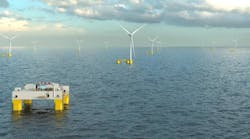John Jacques, Heather Clegg
Robertson Research International Ltd.
Paleogeographies enhanced with source rock data provide a medium by which new play concepts can be identified and the hydrocarbon potential of different parts of the Gulf of Mexico basin can be predicted. An understanding of the plate tectonic history of the Gulf of Mexico during the Late Jurassic is crucial in extending our knowledge of source rock distribution into frontier areas, particularly deepwater and subsalt areas.
Although consideration is usually taken of the depositional setting of the source rocks and their subsidence history, there is often little attempt to explain present day variation of source rock characteristics, rock quality, and maturation history in the light of the tectonic evolution of the basin. The Gulf of Mexico is no exception.
With the use of new technology to capture multiple source rock property datasets, digitally processed data can be queried and displayed. This allows plate tectonic relationships to be observed and important inferences made about source rock distribution and quality.
With recent advances in geographic infor-mation systems (GIS) technology, it is possible to capture huge quantities of data over many disciplines, such as:
- Structural geology
- Geophysics
- Petroleum geology
- Geochemistry.
The explorationist is able to rapidly access these datasets, observe temporal and spatial relationships, and perform multi-scenario analyses. With GIS, the explorationist can present the datasets in any combination as maps, allowing a visual assessment of geological relationships. Not confined to 2D (x and y values), current advances can deal with datasets containing z values, such as stratigraphic tops from well or seismic, allowing the data to be contoured and displayed in 3D.
GIS provides enormous scope for the produc-tion of 3D depth structure maps for principal source rock, reservoir, and seals, where depositional thickness and structuring variations can be observed across the basin. Of particular importance are trapping styles, seal integrity, and migration pathways.
Composite plate tectonic modelling
A solution to understanding the environment of Upper Jurassic source rock deposition is to take the present day geochemical data "back through time" by rotating and placing it onto reconstructed paleogeographic time-slice maps. For this, a rigorous plate tectonic reconstruction has to be developed, which can help to elucidate many of the unresolved controversial issues surrounding the Gulf's tectonic development.
The model should provide an adequate determination of the configuration of continental blocks and their expression through time. The position of these blocks should dictate the opening history of the basin and, ultimately, the distribution of different crustal types, which will have a direct influence on subsidence rates.
If alternative models are proposed, understanding the pros and cons of each model can provide a basis for developing a composite model by selecting positive elements from the earlier works. If data were lacking, it would be worthwhile to select two or more contrasting models.
The differences between these contrasting models and their different paleogeographies would offer significant variations on petroleum systems. The strengths and weaknesses of each model can then be identified, and each contrasting paleodepositional model evaluated on the distribution and quality of source rocks, reservoir, and seal, and timing of maturity, structuring, and migration.
GoM models
There is little doubt that the separation and southwards displacement of the Maya (Yucatan) continental block from the Gulf coast margin of the US during the Late Jurassic to earliest Cretaceous was responsible for the generation of oceanic crust and the creation of the Gulf of Mexico basin. So far, only a pre-rift and pre-drift inter-Gulf position has been determined with confidence. Its original pre-tectonic fit with the US Gulf margin has remained a matter of debate because the position of the Maya block provides a constraint on rift geometry and dictates, the opening mechanism that drives the block southwards. This has given rise to two models:
- Southeastward translation, with no or very little (≤ 5º) rotation
- Significant transrotation, either clockwise or counterclockwise.
Of these, the most accepted model is that of significant counterclockwise rotation. However, the timing and amount of transrotation, the position of the pole(s) of rotation, and the identification of first order structural elements that can be directly related to the opening mechanism(s) are highly contentious.
In our effort, magnetic and gravity data, offshore bathymetric, Landsat imagery, onshore topographic elevations, regional seismic, and well control, together with public domain geological and geophysical information, were used to rigorously define original continental block outlines and their pre-tectonic configuration. Using these data, a number of the most prominent contrasting models for GoM evolution were asse-ssed. Problems with continental misfit of palin- spastically restored margins and timing of block movements were identified.
Composite model
In the case of the Gulf of Mexico, a new composite tectonic model was developed to:
- Define different crustal types
- Determine the kinematic history of the Maya block
- Explain the distribution and timing of Mesozoic extensional events
- Identify first-order structures at each stage of the basin's opening cycle.
One of the most attractive elements of this model is that it can explain the development of several sets of offshore basement structures identified from high quality geophysical data. Each set was used to explain the opening mechanism(s) resulting in a range of alternative models. The new composite model offers a solution by regarding each set as an integral part of the basin's opening cycle.
The following tectonic events are recognized:
•Late Triassic to Early Jurassic (~?225-210 Ma) intracratonic rifting related to the initial breakup of Pangea (Syn-rift 1)
•Middle to Late Jurassic low-angle detachment rifting. The main phase of rifting was concentrated in the Bathonian to Bajocian (~?174-162 Ma; Syn-rift 2), initiating as oceanic crust was created in the Central Atlantic at ~175 Ma. North-west-southeast directed opening in the Central Atlantic was manifested along the northern Gulf coast by northeast-southwest rift basins segmented by northwest-southeast transfer faults
•Late Jurassic first phase rotation. Starting in the Callovian and continuing into the Late Kimm-eridgian (~162-154 Ma), this represents the first phase of counterclockwise rotation (~26°) of the Maya block, about a pole located in Central Florida. This created a continental transfer fault set, developed as small circles to the pole of rotation. Oriented north-northwest to south-southeast along the northern Gulf margin, they controlled rift activity (Syn-rift 3), creating a major central graben and several half-graben complexes, which controlled variations in Callovian depositional thickness
•Late Jurassic to Earliest Cretaceous second phase rotation. This counterclockwise rotation of the Maya block appears to have started in the late Kimmeridgian (~154 Ma), marking the onset of oceanic crust generation (drift) and the establishment of a marine seaway through the southeastern part of the basin. It involved ~36º of rotation about a pole located in the southeastern Gulf, which continued into the late Berriasian (~142 Ma). Producing north-south directed seafloor spreading, it was facilitated by the development of north-northeast to south-southwest oceanic fractures, forming small circles to the pole of rotation.
Depositional environments
With the tectonic model in place, a framework can be established that outlines the kinematic and crustal dynamics of the evolving basin, and the timing and longevity of events.
Two key hydrocarbon-producing areas can be recognized: the Louann salt province in the north and the Campeche salt province in the south. Both are characterized by thick accumulations of Callovian salt, which were mobilized during phases of sediment loading. In both these areas, the most prolific source rock is of Tithonian age. During this time period, the Maya block was in its second phase of rotation (drift), with oceanic crust generation in the central part of the basin.
Tithonian paleogeography infers:
•The evolution of the Gulf of Mexico basin was dominated by passive margin development with transgression at or near its peak, while to the west in west-central Mexico, stratigraphic infill was a function of Mesozoic Pacific arc-related tectonism and sediment supply
•Along the northern coastal margin of the Louann salt province, the depositional environment was dominated by great influxes of terrigenous coarse clastics supplied by several major river systems draining the continental interior of North America. This gave rise to several large, deltaic complexes
•In the Salinas – Sureste basin, restricted marine conditions prevailed in an embayment established between the emergent Maya block and Chiapas Massif. The resultant low energy, anoxic environment in the Campeche Embayment produced the organically rich, calcareous shales of the Pimienta Formation (and time-equivalents), the most prolific source rock of southern Mexico.
Petroleum system potential
Due to depth of burial, information on offshore Tithonian source rock distribution and quality can only be obtained indirectly from analysis of oils derived from Cretaceous and Tertiary reservoirs. In deepwater (200 m to 1,750 m) to ultra-deepwater (>1,750 m) areas, where well penetration of this section is sparse, alternative data have to be sought. These include seep data from piston coring and sea surface images of active seeps from satellite remote sensing. These are generally viewed in a present day context, but rotation and placement of data onto a reconstructed paleogeography provide an extremely powerful way of depicting such information in its original depositional setting.
Using such maps, inferences from known source rock quality distribution patterns and predictions of their extent into frontier areas can be made. To illustrate this, three areas are discussed.
Salinas – Sureste basin. Well data in the Sonda de Campeche area indicate that the average thickness of the productive Tithonian source interval can be greater than 200 m and the average total organic carbon (TOC) greater than 10%. The widespread seeps and oil slicks offshore and in the Campeche to Challenger Knolls strongly suggest a westward and northeast extension of this Upper Jurassic-sourced hydrocarbon system.
Forming part of the Campeche salt province, the deeper offshore areas of this basin may be analogous to the deepwater areas of the northern Gulf, with abundant exploration opportunities in both mini-basins and in subsalt plays.
Tampico basin. Onshore well and seismic data indicate that thick occurrences (up to 500 m) of the Pimienta formation formed in isolated grabens of the Tampico basin. Of particular interest is the possibility that this source rock system extends offshore, where the gravity-driven Mexican foldbelt occurs, providing the potential for giant fold and thrust related accumulations. This possibility is heightened numerous seeps along this trend.
Northern offshore Gulf. Offshore well data indicate the development of an extensive organic rich Tithonian carbonate source containing up to 15% TOC. Contributing to the many seeps, this source rock extends across the northern Gulf (Alaminos Canyon-Garden Banks-Green Canyon area). This carbonate province is limited to the east (Atwater Valley-Mississippi Canyon) and southeast (Lund) by a clastic dominated area. Seep analysis shows that the depositional setting contained a high clastic input. This is most likely to have come from the large deltaic complex in southeast Alabama and the Florida panhandle, as the emergent Maya block had drifted by oceanic crust generation far enough south to be an unlikely source.
New plays
The final step is to use the findings derived from the analysis of the paleogeographies and take this information into the future by integrating it with play fairway maps. This allows new play concepts to be identified and the hydrocarbon potential of different parts of the Gulf of Mexico Basin to be predicted.
Conclusions
For explorationists to understand fully the petroleum systems of a basin, an appreciation of tectonics role through time is imperative. A classic example is the Gulf of Mexico Basin, which highlights how the distribution and quality of source rocks can determine where future areas of exploration should be targeted.
The beauty of this approach is that it can also be used to understand the distribution and quality of reservoirs and seals. Together with source rocks, these provide the essential elements of a petroleum system.







